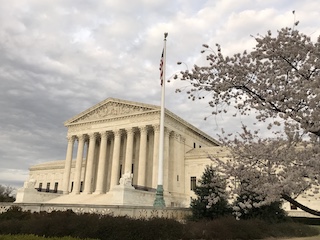One evening in 2007, Annette White attended a gathering with Ervine Davenport in Michigan. On the drive home, Mr. Davenport killed Ms. White.
At trial, there was no issue of who killed White, but Davenport claimed self-defense and even testified to that effect. According to Davenport, White grew angry on the way home and tried to grab the steering wheel. She then pulled out a box cutter from her purse and cut Davenport’s arm, according to Davenport at trial. Davenport then responded by extending his right arm and putting his hand under her chin, pinning White against the right side of the car.
Davenport claimed that he did not realize it, but his pressure to her neck area resulted in her death. Mr. Davenport was six feet, five inches tall and weighed nearly 300 pounds. Ms. White was five feet, two inches tall and weighed 103 pounds.
Instead of contacting the police after this struggle, he not only abandoned her body on the roadside, but he visited her house and stole electronics and food.
The prosecution presented evidence at trial that Dr. Davenport had bragged to others before the killing that if he had a problem with someone, he would choke the person. Days before Ms. White’s death, he had choked another woman until she passed out and urinated on herself. In the days after Ms. White’s death, he told a witness he “had to off” Ms. White.
After a seven-day trial, during which Davenport was shackled at times, the jury convicted Davenport of first-degree murder.
 U.S. Supreme Court
U.S. Supreme Court
On direct appeal in state court, Davenport sought to have his conviction set aside in light of Deck v. Missouri (2005) 544 U.S. 622, wherein the U.S. Supreme Court held that the Fourteenth Amendment’s Due Process Clause generally forbids shackling a defendant at trial absent “a special need.” Id., at 626. The case made its way up to the Michigan Supreme Court, in which the court found no “special need” articulated in the record, so it found a Deck violation had occurred and remanded the case to the trial court to determine under Chapman v. California (1967) 386 U.S. 18, whether the prosecution could establish that the Deck error was harmless beyond a reasonable doubt.
On remand, the trial court conducted an evidentiary hearing at which all 12 jurors testified that the shackles had not affected their verdict. Five jurors remembered seeing his restraints; the remaining seven did not. The jurors also found the illegal restraints did not affect their verdict, which they testified relied upon overwhelming evidence of Davenport’s guilt. The trial court then affirmed that the People had carried their burden of showing harmlessness beyond a reasonable doubt.
Mr. Davenport appealed this ruling and the Michigan Court of Appeal affirmed the trial court. The Michigan Court of Appeals held that “the prosecution proved beyond a reasonable doubt that the shackling error did not affect the verdict.” The Michigan Supreme Court then declined Mr. Davenport’s request for discretionary review.
Mr. Davenport then petitioned for federal habeas relief in the Western District of Michigan. The District Court found relief unwarranted under the Antiterrorism and Effective Death Penalty Act of 1996 (AEDPA), which limits the power of federal courts to issue habeas relief to state prisoners. See 28 U.S. C. § 2254(d).
As relevant here, AEDPA provides that, when a state court has already ruled on the merits of the habeas petitioner’s claim, he must show that decision was either (1) “contrary to” or an “unreasonable application of” clearly-established federal law, as determined by the decisions of the U.S. Supreme Court, or (2) based on an “unreasonable determination of the facts” presented in state-court proceedings. 28 U.S.C. § 2254(d). The Western District found that the state court correctly applied the harmless-error rule from Chapman and that there was no unreasonable determination of the facts.
Mr. Davenport then appealed this ruling to the Sixth Circuit, where a divided panel reversed!
The Sixth Circuit declined to analyze the case under AEDPA and instead, found that the Western District of Michigan should have evaluated the trial court under Brecht v. Abrahamson (1993) 507 U.S. 619, handed down before Congress adopted AEDPA. Brecht sought to adapt Chapman’s harmless error rule, developed for cases on direct appellate review, for use in federal habeas proceedings. Brecht, 507 U.S. at 633-635.
Brecht effectively inverted Chapman’s burden. Brecht, at 635. Rather than require the prosecution to prove that a constitutional error is harmless, Brecht held that a state prisoner seeking to challenge his conviction in collateral federal proceedings must show that the error had a “substantial and injurious effect or influence” on the outcome of his trial. Id., at 637.
Persuaded that Davenport could satisfy his burden under Brecht, the panel majority ordered Michigan to retry or release him promptly.
Michigan then filed a petition for certiorari to the U.S. Supreme Court. The Supreme Court then ruled that when Congress supplies a constitutionally valid rule for decision (i.e., AEDPA), federal courts must follow it. However, when a state court has ruled on the merits of a prisoner’s claims, the federal court must apply both tests, meaning both AEDPA and Brecht, to determine the availability of federal habeas relief.
We present this summary to the reader because this is new law on what is, while improbable, hypothetically possible in many cases and therefore must be understood even at the state trial court level.
The citation for the United States Supreme Court ruling discussed above is Mike Brown, Warden v. Ervine Davenport (2022) 596 U.S. ____.
For more information about a petition for writ of habeas corpus, please click on the following articles:
 U.S. Supreme Court
U.S. Supreme Court